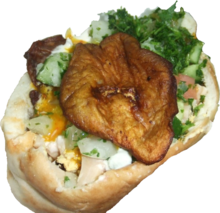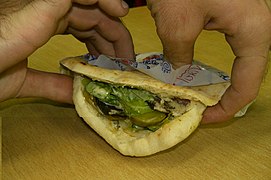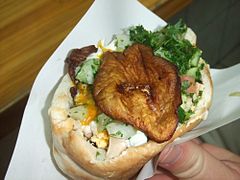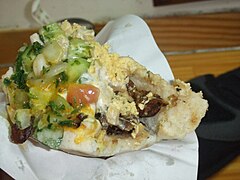Sabich
 | |
| Course | Breakfast (among Iraqi Jews) and Street food (entire country), Sandwich |
|---|---|
| Place of origin | Iraq |
| Main ingredients | Traditionally laffa, although pita is often used, eggplant, hard boiled eggs, Israeli salad, amba, parsley, tahini sauce, and hummus |
| Ingredients generally used | Potato, onion, and zhug |
Sabich or sabih (Hebrew: סביח [saˈbiχ]) is an Israeli sandwich of pita or laffa bread stuffed with fried eggplants, hard boiled eggs, Chopped salad, parsley, amba and tahini sauce.[1] Its ingredients are based on a traditional quick breakfast of Iraqi Jews. Sabich is sold in many businesses throughout Israel.
Etymology[]

There are several theories on the origin of the name sabich.
Many credit the name to the first name of Sabich Tsvi Halabi,[2] a Jewish man born in Iraq who operated a small Ramat Gan restaurant, who is credited for originally serving the sandwich.[3][4]
Another theory is that sabich is an acronym of the Hebrew words "Salat, Beitsa, Yoter Ḥatsil" סלט ביצה יותר חציל, meaning "salad, egg, more eggplant". This is probably a humorous interpretation and hence a backronym.[5]
History[]
The idea of the sabich sandwich was probably brought to Israel by Iraqi Jews, who came in the 1940s and 1950s as refugees. On mornings when there was no time for a cooked breakfast, Iraqi Jews ate a cold meal of pre-cooked fried eggplant and hard-boiled eggs, either stuffed into a pita bread or with boiled potatoes. The eggplants would be cooked the night before.
In Israel, these ingredients eventually became popular as fast food. The dish is said to have been first sold in Israel in 1961 at a small stall on Uziel Street in Ramat Gan.[6][4] In 2020 a square adjacent to the establishment's current location was named "Sabich square".
A version without the bread or pita is called Sabich salad ("סלט סביח" - "Salat Sabich" in Hebrew).
Ingredients[]
Sabich, served in pita bread, traditionally contains fried eggplant slices, hard-cooked eggs, a thin tahini sauce (tahini, lemon juice, and garlic), Israeli Salad, chopped parsley, and amba. Some versions use boiled potatoes. Traditionally it is made with haminados eggs, slow-cooked in Hamin until they turn brown. According to the diner's preference it can be served topped with green or red zhug as a condiment and sprinkled with minced onion.
Gallery[]
See also[]
- Culture of Israel
- Cuisine of the Mizrahi Jews
- Israeli cuisine
- Jewish cuisine
- Middle Eastern cuisine
References[]
- ^ "Tales of a wandering chickpea". The Santa Fe New Mexican. Archived from the original on 30 June 2012. Retrieved 21 October 2008.
- ^ "When Your Father Shares a Name with a National Dish". Jewish Food Society. Retrieved 1 February 2021.
- ^ "אין כמו, אין כמו עמבה: מדריך הסביח - מדן ועד אילת", ynet, 12.11.06
- ^ a b Ungerleider, Neal (1 April 2011). "Hybrid Power: The Iraqi-Israeli Sabich". Saveur. Archived from the original on 7 October 2011.
- ^ "No 'Cultural Genocide' Here: An Israeli Sandwich Stays Out Of Hummus Wars". The Forward. Retrieved 9 October 2020.
- ^ Walla News 2007
- Israeli cuisine
- Mizrahi Jewish cuisine
- Eggplant dishes
- Street food
- Egg sandwiches
- Vegetarian sandwiches
- Shabbat food





